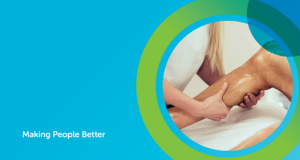In This Section
What is Knee Pain?
Your knees are one of the most important joints in your body. We use our knees to walk, run, bend and jump – so if you are experiencing aches and pains in your knee, it can have a big impact on your life. Knee pain can be caused by a variety of conditions:
What is Osteoarthritis of the Knee?
Your knee is like a hinge. Cartilage covers the ends of the bones, to allow smooth movement when you bend or straighten it.
Osteoarthritis is when the cartilage is gradually worn away with age or after injury, mainly at the points of greatest pressure. The two surfaces rub against each other – sometimes you can hear or feel it. This can lead to pain, stiffness, loss of movement, swelling and deformity. It can lead to your knees giving way because the muscles around the joint can become weak.
How can I help myself?
Pain Relief
- Heat – this can be soothing and help decrease pain
- Discuss the use of painkillers and/or anti-inflammatory tablets with your GP or Pharmacist.
- Ice – This can reduce swelling and pain.
Controlling the swelling
- Cold
- Tubigrip Bandage – for occasional use
- Anti-inflammatory gels – see your pharmacist or GP for advice
Reducing Stiffness
- Try to avoid long periods of sitting. Aim to bend and stretch your legs a few times every half hour and just before you get up
- Your physiotherapist may give you an exercise programme to reduce knee stiffness and strengthen the muscles which control your knees. Try this daily, starting gently at first.
Useful Hints
- Know your limitations. Limit any activities which make your knees painful or swollen.
- When walking upstairs, on kerbs or onto buses, put your best leg up first.
- When coming downstairs, put your most painful leg down first.
- Take care when walking on uneven ground, as this can aggravate your painful joints.
- If getting out of a chair is difficult, try a higher chair or raise the seat with a firm cushion. If possible, use a chair with arms.
- If getting out of bed is difficult, try rolling onto your side and pushing yourself up into sitting as you swing your legs over the side of the bed.
- Avoid or limit carrying heavy loads, e.g. shopping, because the extra weight may strain your knees and back.
- Moving your knees up and down in a warm bath can be beneficial. Swimming is often a good form of exercise, although vigorous breaststroke may be painful and you should therefore adapt your stroke if necessary.
- Watch your weight. The more you weigh, the more your knees have to carry.
- Walking is an excellent exercise for the body in general and especially for the leg muscles. Walk at a speed which does not produce increased pain or swelling.
- If you are using a stick, place it on the ground at the same time as the affected leg. The stick should normally be held in the hand opposite the affected leg. It should have been measured correctly
Surgical options
Injury and disease can cause severe knee pain and discomfort which interferes with normal movement and mobility. Your doctor may advise you to consider knee replacement surgery if you have tried other treatments which have not been successful in reducing that pain and improving the quality of life.
Total knee replacement surgery, also known as arthroplasty, is when a damaged, worn or diseased knee is replaced with an artificial joint.
What is Anterior Knee Pain?
Anterior knee pain (AKP) is pain felt at the front of the knee around the knee cap area. The exact location of the pain may be difficult to describe and there may not be an obvious reason as to why the pain has started.
How is AKP diagnosed?
Your doctor will ask you several questions to help rule out other conditions that could be causing your symptoms. They will also need to examine your knee to look for any swelling at the knee joint. If other conditions are ruled out then it is likely that the problem is AKP. If your doctor finds that the knee joint is swollen (this is called an effusion) then it may be that something else is causing the symptoms.
At this point the doctor usually suggests getting some X-rays of the knee joint and taking a blood test from you. The results of these investigations will help us to work out what might be causing the swelling and will help your doctor decide on the best way to manage your symptoms.
How is AKP treated?
The most common reason why people get this condition is due to weakness in the quadriceps muscles (thigh muscles). If this muscle is strengthened then it is likely that the symptoms of AKP will settle down and improve.
It is very important to note that the symptoms of AKP can take a long period of time to settle down and it is not unusual for symptoms to initially worsen when exercises are first started. It is expected that the following exercises will need to be continued on a regular basis over at least a 12 week period, and often longer, for benefits to be seen.
What exercises are recommended?
Although a number of different exercises can be done to strengthen the thigh muscles, one of the best ways to do this is by doing a mini squat.
Which exercise should I start with?
This exercise can be graded into easy, moderate and hard versions. It is sensible to start with the easy version of this exercise and progress to the moderate and hard versions as strength and symptoms allow. In addition to this exercise, it is often beneficial to introduce the use of an exercise bike if there is one available (ask friends and family if one can be borrowed). This will allow the leg muscles to be strengthened without excessively loading the knee joint or making it too uncomfortable.
What happens if the pain doesn’t get better?
If symptoms are improving but are only doing so slowly then it is still a sign that the treatment is working. We recommend that the exercises are continued and that more time is allowed for the symptoms to improve.
If symptoms continue, despite exercises being attempted and all other factors being addressed, then we recommend you see your doctor for further advice. If your doctor agrees that you have completed your treatment then they may arrange for an appointment with a specialist physiotherapist or doctor. The physiotherapist/doctor will re-assess your symptoms, carry out a further examination and, if appropriate, consider further investigations such as ultrasound or an MRI scan.
We find that in the majority of cases, patients simply require extra support with exercises and do not need further investigations. Investigations such as ultrasound and MRI scans are never a substitute for a careful examination by an experienced physiotherapist or doctor.
It is important to understand that:
- It may take some time (up to 6 months) of supervised rehabilitation from a physiotherapist for the symptoms to change.
- In some cases of AKP, the pain may not completely go away and some symptoms may remain or fluctuate throughout life. This is normal and should not be a cause for concern. In most cases the symptoms can be kept under control with correct exercise.
- In the vast majority of patients the symptoms of AKP will improve by doing the correct exercise and doing them for long enough.
- Although painful, AKP does not indicate a serious underlying condition or one that is likely to cause disability in later life.
Exercises for AKP
These exercises are designed to strengthen the muscles in the thigh and buttocks. There are 4 exercises to work through. These exercises are graded in terms of their difficulty – easy, moderate, hard and very hard.
Exercise 1 – Easy
- Supported or seated squat 1. Find a table or edge of a chair that you can perch on as shown here which allows your knees to have a small bend. 2. Once you are in this position then the exercise is to contract your thigh muscles and buttock muscles. You may want to place your hands on to your thighs to feel the contraction. You may feel as though you lift up slightly as your buttock muscles contract. It is important to hold this contraction for 10 seconds and then relax. 3. Repeat the exercise 10 times. 4. This is one set, you need to build up to do 3 sets of 10 repetitions. Once you have done 10 repetitions you may want to stand up, have a walk around and then when you are ready return to the starting position for the second or third set. During the exercise it is important to make sure your hips and knees are in alignment as demonstrated here and not allow your knees to roll in towards each other. Remember, it is normal to experience increased pain whilst doing the exercise and initially afterwards. This should get less as you become more familiar with the exercise and as you become stronger. When you no longer experience discomfort or fatigue and you feel that this exercise has become easy then it is sensible to move on to the next level of exercise.
Exercise 2 – Moderate
- Double leg squat 1. You may find it helpful to have a chair placed in front of you, as demonstrated here, to help with your positioning during the exercise. 2. As you start to bend into a squat position, it is important to remember to keep your hips, knees and feet in alignment and to stick your bottom out as you go into the squat position. 3. When you first start doing this exercise you may feel that you are only able to squat down by a small amount. As your strength improves the aim is that you will be able to progress further into a squat position. 4. Once you are in the squat position, you must hold this position for 2-3 seconds and then return to the start position. 5. Repeat the exercise 10 times. 6. This is one set, and you need to build up to do 3 sets of 10 repetitions. Once you have done 10 repetitions you may want to stand up, have a walk around and then when you are ready, return to the starting position for the second or third set. Remember, it is normal to experience increased pain and or fatigue whilst doing the exercise and initially afterwards. This should get less as you become more familiar with the exercise and as you become stronger. When you no longer experience discomfort or fatigue and you feel that this exercise has become easy then it is sensible to move on to the next level of exercise.
Exercise 3 – Hard
- Single leg squat 1. You may find it helpful to have a chair placed in front of you, as demonstrated here, to help with your positioning during the exercise. 2. As you start to bend into a single leg squat position, it is important to remember to keep your hips knees and feet in alignment and to stick your bottom out as you go into the squat position. 3. When you first start doing this exercise you may feel that you are only able to squat down by a small amount. As your strength improves the aim is that you will be able to progress further into a squat position. 4. Once you are in the squat position, you must hold this position for 2-3 seconds and then return to the start position. 5. Repeat the exercise 10 times. 6. This is one set, and you need to build up to do 3 sets of 10 repetitions. Once you have done 10 repetitions you may want to stand up, have a walk around and then when you are ready, return to the starting position for the second or third set. Remember, it is normal to experience increased pain and or fatigue whilst doing the exercise and initially afterwards. This should get less as you become more familiar with the exercise and as you become stronger. When you no longer experience discomfort or fatigue and you feel that this exercise has become easy then it is sensible to move on to the next level of exercise.
Exercise 4 – Very hard
- Decline single leg squat This is the hardest exercise to do as it places the biggest load through the knee cap joint but it is very important in helping to address the pain and control problems associated with walking down stairs or hills as it replicates the demands placed onto the joint during these activities. For this reason you may notice that pain and fatigue are easily provoked. If you experience pain and or fatigue then start with performing a shallow squat on a small decline and then as symptoms allow progress to a deeper squat on a greater decline. 1. To do this exercise you will need to place a small book under your heel. 2. In this position move into the small squat, remembering the importance of keeping your hips, knees and feet in alignment and to stick your bottom out as you go into the squat position. If you feel unsteady then you may want to place one hand on a wall to help provide some balance support as you do the exercise. 3. Once you are in the squat position, you must hold this position for 2-3 seconds and then return to the start position. 4. Repeat the exercise 10 times. 5. This is one set, and you need to build up to do 3 sets of 10 repetitions. Once you have done 10 repetitions you may want to stand up, have a walk around and then when you are ready, return to the starting position for the second or third set. As this exercise becomes easier you can progress into a deeper squat and gradually increase the decline by using a thicker book.
What are the Knee ligaments/cartilage?
Knee ligament injuries are very common and are often sports related, although they can occur from a trauma during everyday activities. The most common are:
- A sprain/strain – one or more ligaments is overstretched through twisting or pulling
- A meniscus, that acts as a ‘shock absorber’ in your knee this could be caused by an acute injury or trauma or due to a more gradual onset because of deterioration/wear and tear
- A tear – either a partial tear or complete rupture of the ligament/tendon/muscle damage to the cartilage in your knee – the cartilage is a crescent-shaped disc called
Ligaments connect one bone to another. The ligaments outside your knee joint are called the medial collateral ligament and the lateral collateral ligament. They provide your knee with stability and limit the amount it can move from side to side.
The medial collateral ligament is strong can be sprained or completely ruptured (torn) if you twist your straightened leg at the same time as being knocked sideways, for example, when being tackled in rugby or football.
The ligaments inside your knee joint are called the anterior cruciate ligament (ACL) and the posterior cruciate ligament. These ligaments provide stability to your knee when it is in different positions, particularly in the forward and backward movements of the knee joint. People who sustain an injury to their ACL may complain of symptoms of the knee ‘giving out’.
If you have had gradual onset of knee pain without having had any kind of injury, ligament damage is unlikely to be the cause.
Preventing knee ligament injury
Since usually due to sports injuries or accidents, knee ligament damage is difficult to prevent however the following considerations may help:
- Always warm up before intense exercise
- Wear appropriate footwear for the activity and replace footwear if it shows signs of wear
- A good level of general fitness will keep muscles around the joint healthy and supportive
Medial Collateral Ligament Injury
- The medial collateral ligament is strong and can be sprained or completely ruptured (torn) if you twist your straightened leg at the same time as being knocked sideways, for example, when being tackled in rugby or through a skiing injury.
- Pain is felt immediately on the inner aspect of the joint and it may be tender to press over the area
- In severe MCL injuries there may also be cartilage (medial meniscus) involvement causing the knee to swell rapidly.
How can I manage an MCL injury?
- Rest the leg and apply ice wrapped in a towel or cloth for 10-15mins every few hours for the first 48hours after the injury.
- Take some painkillers so that you are comfortable.
- A simple strain of the ligament should settle very quickly over 2-4 weeks.
- If things are not improving seek medical advice.
Lateral Collateral Ligament Injury
- Less common injury, often associated with major knee trauma rather than in isolation.
- If occurs alone it is due to a force from the inside of the thigh causing the outside aspect of the joint to widen.
- The knee is painful and tender to press down the outer aspect of the joint.
How can I manage an LCL injury?
- Rest the leg and apply ice wrapped in a towel or cloth for 10-15mins every few hours for the first 48hours after the injury.
- Take some painkillers so that you are comfortable.
- A simple strain of the ligament should settle very quickly over 2-4 weeks.
- If things are not improving seek medical advice.
Anterior Cruciate Ligament Injury
The ligaments inside your knee joint are called the anterior cruciate ligament (ACL) and the posterior cruciate ligament. These ligaments are vital to the stability of your knee joint when it is in different positions, particularly in the forward and backward movements of the knee joint.
- A torn ACL is a relatively common knee injury amongst sports people and is more common in female athletes
- A torn ACL can also result from a direct blow to the knee, usually the outside, as may occur during a football or rugby tackle. This injury is sometimes seen in combination with an MCL tear and medial meniscus (cartillage) injury In 80% of injuries there is no contact with another athlete.
- A torn ACL usually occurs through a twisting force being applied to the knee whilst the foot is firmly planted on the ground or upon landing.
Symptoms of a torn ACL
- There may be an audible pop or crack at the time of injury
- Sudden onset of pain in particular immediately after sustaining the injury
- Immediate onset of extensive swelling is usual though may be delayed in some cases
- An initial feeling of instability, which may be masked later by extensive swelling
- Inability to continue exercising
How do I manage an ACL injury?
- Stop the sport/activity immediately (usually it’s impossible to play on)
- Use simple pain killers
- Rest and application of ice packs wrapped in towel or cloth for 10-15mins every few hours for the first 48hours
- Seek medical advice Immediately
Treatment for an Anterior Cruciate Rupture
Firstly a full assessment of the knee is required to ascertain whether other structures within the joint have been damaged by the injury. (eg. MCL and meniscus) An MRI scan is usually performed Treatment may be non-surgical with physiotherapy and knee bracing or surgical with repair of the damaged ligament. There are various techniques used to repair the ACL and which is used depends on the patient, the severity and location of the tear and the degree of damage to other structures in the knee.
When is Surgery Required?
Surgery is performed more often than not following Anterior Cruciate ligament tears. The decision on whether to operate is based on a number of factors, including the persons age; lifestyle; sporting involvement; occupation; degree of knee instability and any other associated injuries Older people who are less active and perhaps injured their ACL following a fall as opposed to during sport would be unlikely to undergo surgery A younger, fit person who regularly plays sport and would be more likely to adhere to a complex rehabilitation program is very likely to be offered an operation.
This pain on the outside of your knee, is also called Runner’s Knee.
The iliotibial band, a thick band of fibrous tissue that runs down the outside of the leg, works in coordination with several of the thigh muscles to provide stability to the knee and to help in flexion of the knee joint. When irritated, movement of the knee joint becomes painful. Usually the pain worsens with continued movement, and resolves with rest.
Vita is an award-winning, CQC registered healthcare provider














